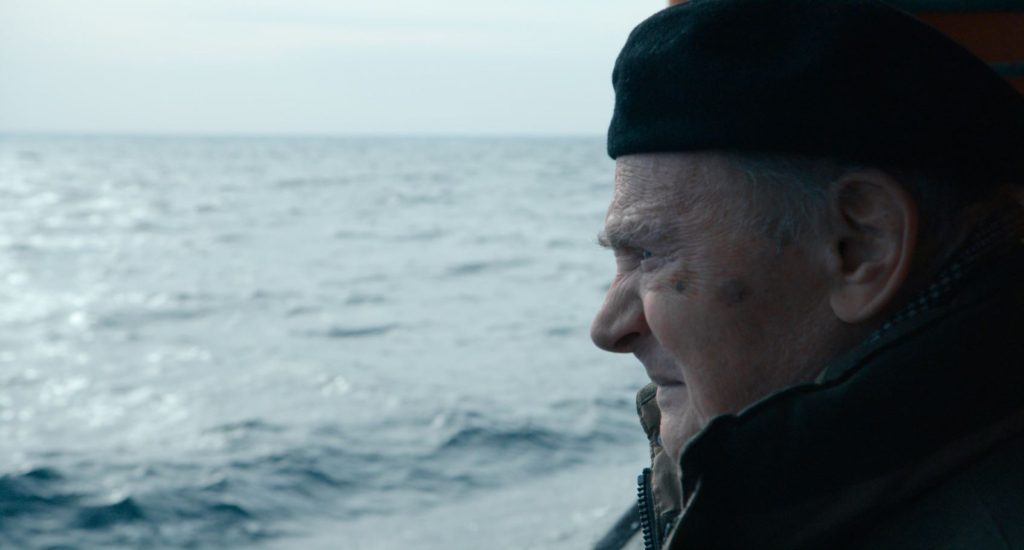Review: The Jump (2020)

On November 23rd 1970, in the midst of the negotiations between the American and Soviet representatives regarding the fishing of the coast of New England, a Lithuanian sailor Simas Kudirka jumped from his ship Soviet Lithuania, swam across the cold Atlantic waters and boarder the US Coast Guard ship Vigilant, pleading for the political asylum only to be turned down and given back to the Soviets. Back in the USSR, he was tried for treason and sentenced to prison, which outraged the Americans, especially the members of the Lithuanian and, generally speaking, Eastern European communities, who protested and pressured the government to react on Kudirka’s behalf.
The real story of Simas Kudirka was turned into an “inspirational” TV movie The Defection of Simas Kudirka, starring Alan Arkin in the title role, but now the discreet Cold War hero has got his own documentary. The Jump was directed by Giedrė Žickytė, known for her directorial and production work on the documentaries How We Played the Revolution (2012), Master and Tatyana (2015) and this year’s festival hit The Earth Is Blue as an Orange (link). The film premiered at Warsaw, before starting its festival tour on which it made stops at, among other festivals, Rome, DOC NYC and Jihlava. We got the chance to see it at Black Nights Film Festival, where it played in the Baltic Competition section.

The Jump’s clear three-act structure serves the film well. In the first part, Kudirka, still alive and quite lively, assumes the role of the narrator and the re-enactment actor, reliving the details of his faithful jump to freedom. The second part deals with his time in various Soviet prisons (to be honest, gulags) and the political pressure created in the US for his freedom lead by the prominent Lithuanian-American figures Daiva Kezys and Grazina Paegle and realized by the Congressman Hanrahan’s efforts in the national and international political arena. The most interesting part of the fight was the legal gymnastics so Kudirka could get the American citizenship, with the details too precious to reveal in the review. In the final third, Kudirka revisits the places from his American life, before he went back to his homeland in 2007, pointing out that the American Dream and the American reality are two different things.
Throughout the film, Žickytė blends the newly-filmed material, consisting mainly of interviews and re-visits to the places where action took place 50 years ago, with the various archival footage, usually the news television shows, in a smooth fashion. The Defection of Simas Kudirka is also referenced generously and it makes its own cameo. The film’s style is not particularly lavish, though it looks good with Rimvydas Lepius’ handsome cinematography, Thomas Ernst’s and Danielius Kokanauskis’ precise editing and the musical score by Kipras Mašanauskas that is finely calibrated and glides through the various genres of neo-classicism. However, the lively nature of the film’s protagonist and his extraordinary life story is The Jump’s greatest asset, making it a respectful and inspirational piece of documentary cinema.
Original title: Šuolis
Year: 2020
Runtime: 84’
Countries: Lithuania, Latvia, France, USA
Languages: Lithuanian, English
Directed by: Giedrė Žickytė
Written by: Giedrė Žickytė, Josh Alexander
Cinematography by: Rimvydas Lepius
Editing by: Thomas Ernst, Danielius Kokanauskis
Music by: Kipras Mašanauskas
Sound recording by: Ignas Mateika
Production design by: Ramune Liepaitė
Visual effects by: Jonas Zagorskas
Colourist: Jonas Zagorskas
Produced by: Giedrė Žickytė, Uldis Cekulis, Catherine Siméon, Daniel J. Chalfen
Production companies: Moonmakers, VFS Films, Faites un voeu, Naked Edge Films
Sales: MetFilm Sales

















2020-12-03 @ 12:40
is it possible to buy/rent this film somewhere?
2021-10-24 @ 19:10
Still in the movie theatres, should be available later on.